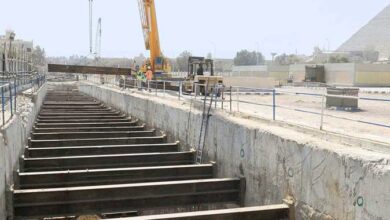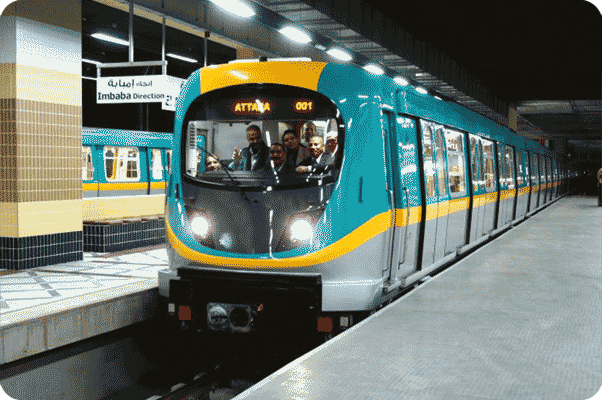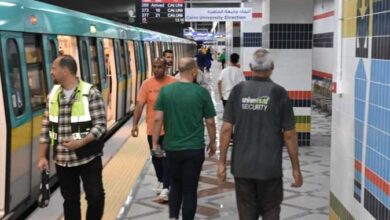
As you ride along on the subway cars daily, passing stations one by one, you might stumble on the pronunciation of a station that is dubbed "Kozika, Kotceka, or Costa Rica…"
A question may pop into your head moments later wondering: "What is the meaning of Kotceka?"
You might think that the names of the metro stations mean nothing, with the exception of those that refer to specific personalities, such as Ahmed Orabi, Sadat or Gamal Abdel Nasser. The names that you see on the subway stations, however, are of historical significance.
Here are 11 examples of historical metro stations:
11. Helwan Station

The last stop on the first subway line is Helwan station, located in what used to be a Pharaonic city dating back more than 7,000 years. The first water dam in Egypt's history was constructed in Helwan. The area was turned into an important city after an epidemic spread in Fustat under the rule of Abdel Aziz bin Marwan, who transferred his residence and the capital to Helwan temporarily. Marwan established palaces and orchards there and it became a green city bustling with life.
As for the name Helwan, some say the name was derived from the area's old name "Ein Anne," according to the Cairo Governorate's website.
Others say the city was called Helwan by Marwan after Helwan city in Iraq.
10. Wadi Hof Station

The Wadi Hof area was called al-Wadi (The Valley) long ago because the land was closer to sea level than the surrounding towns. Wadi Hof is in south Helwan. It borders with Mokattam hill and the Autostrade highway in the north, and with the Nile Corniche to the south .
9. Kotceka Station

The wealthy Greek man Kocika in a photo that dates back to the early 20th Century.
Egyptians call the station Kotceka to facilitate the pronunciation of the foreign name, which refers to the richest Greek resident in Egypt in the early 20th Century. According to an old edition of the Monday Journal in 1942, his wealth was estimated at LE4 million at the time. The Greek man contributed to the first Egyptian ambulance storage facility as well as the first ambulance in 1916. Kocika also established the first factory to produce alcoholic beverages in Egypt in 1893.
8. Maadi Station

The Maadi Metro Station.
The Maadi neighborhood was planned by Canadian officer Alexander Adams. It was a small quiet town, away from relative congestion in traditional Egyptian cities. Adams created Maadi as a residential neighborhood in a British style with straight streets and two-story villas. It was called Maadi after a ferry boat, called the Maadia in Egyptian Arabic, which was used to cross the Nile in that area at that time.
7. Thakanat al-Maadi (Maadi Barracks) Station
Thakanat al-Maadi was named such because Khedive Abbas Hilmi II was annoyed by the presence of British colonizers in Egypt who were taking advantage of his father's, Khedive Ismail, palaces. He reappropriated the al-Gezira and Hadabet al-Ahram palaces, but left them the Ismailia Palace. Later, British soldiers were moved from the Ismailia Palace to a camp near Maadi called Thakanat al-Maadi.
6. Sakiat Mekky (Mekky's Water Wheel) Station
The name of this station refers to a water wheel that existed in the Giza area many years ago. A village was created to provide pilgrims with drinking water on their way to Mecca, and was later named after the wheel, "Sakiat Mekky."
The village was part of the Zainab Khatoon property, a descendant of Mohamed Ali Pasha. The land was seized and distributed to farmers following the 1952 revolution.
5. Al-Demerdash Station
This station was named after Sheikh Abdel Rahim Pasha al-Demerdash, a philanthropist who created the Demerdash Hospital, donating LE100,000 for the building and equipment of the hospital; a large sum at the time.
4. Al-Khalafawy Station
The station was named after the Khalafawy area in the Shobra district. The area was named in turn after Sheikh Mohamed al-Khalafawy, an Al-Azhar senior scholar who stood against the Khedive Tawfiq during the Orabi Revolution.
3. Ataba Station

This particular station is named after Ataba Square. The square was named by Khedive Abbas Hilmi I and had originally been a pond nearly 500 years ago.
After the Ottomans entered Egypt, the Ottoman viceroy built a house on the eastern edge of the pond known as al-Ataba al-Zarqa (Blue Threshold). The house was later demolished by Khedive Abbas Hilmi I and the area was renamed al-Ataba al-Khadra (Green Threshold) because Hilmi hated blue.
2. Al-Mazalat Station
Mohamed Ali Pasha paved a wide road between Cairo and Shobra in what is now Shobra Street. The street was created to provide a place for residents to picnic and relax outside the capital.
Large trees were placed on the roadside creating shade (Mazalat), hence the name of the station.
1. Al-Marg Station

Before Al-Marg Station existed, the land in the area was quite remote and on the outskirts of Cairo. As it was an area that could grow palm trees and other plants, it became known as Marg (Meadow).
By the end of the last century, the area changed from agricultural land to a residential area.




